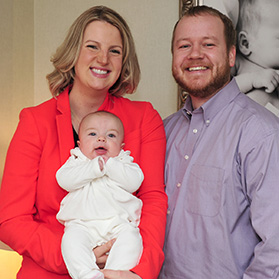Cardiac Patient, Once Dissuaded from Becoming Pregnant, Welcomes Baby

Katie Binzer, of Montgomery, spent years preparing herself for the likelihood that she’d never be able to carry a child. “That was something I always emotionally banked on,” she says.
Her husband, Zach, did, too.
Katie was born with two heart conditions that meant traditional pregnancy wasn’t really an option. She has right ventricular double outlet and dextrocardia with situs inversus, which essentially means her heart formed backwards and the left ventricle is doing the right ventricle’s job.
Katie and Zach Got News They Never Expected
A couple years ago, however, everything changed. Katie’s lifelong cardiologist, Gary Webb MD, of Cincinnati Children’s, gave her and Zach the go-ahead; they started trying for a baby. Dr. Webb said he had a high-risk obstetrician in mind for when they succeeded.
It wasn't until the winter of 2015, when the couple heard two words they thought a doctor would never utter: You’re pregnant.
So Katie’s cardiologists referred her to TriHealth’s Center for Maternal Cardiac Care, a program aimed at giving pregnant women with all forms of congenital and acquired cardiac illness collaborative care throughout their journey.
Katie's Care Team Grows, Anxiety Subsides
Katie’s primary obstetrician was William Schnettler MD, of Tri-State Maternal-Fetal Medicine Associates, who partnered with Katie’s cardiac team to provide the most comprehensive care possible. “I think the defining moment was when we discovered that cardiologists from another hospital were going to be collaborating with our OB,” Zach recalls. “When we had that first meeting, all three docs were in the same room, having the same conversation. They even brought in an anesthesiologist who typically does epidurals to discuss that process for Katie, because pain management for a cardiac patient is different than for a regular patient.”
Katie had more appointments than a standard pregnancy to ensure the safety of her and her baby. Due to complications – that weren’t heart-related – her appointment frequency picked up. She developed placenta previa, a problem where the placenta grows in the lowest part of the uterus and covers all or part of the opening to the cervix. The condition, however, resolved itself by the time Katie was ready to deliver, as it does in 90 percent of cases.
The baby, who Katie and Zach learned was a girl, also had a few heart tests, including an echocardiogram and an electrocardiogram (EKG) at 22 weeks, just to make sure the baby’s heart was functioning properly and that it hadn’t inherited Katie’s condition. Fortunately, she did not.
During the last trimester, the baby had non-stress tests twice a week to make sure her heart rate and movement coincided. “She was very much on target,” Katie says.
From there, Katie was scheduled for induction on Sept. 1, 2015, three weeks early, so the baby would be small, which would require less pushing, meaning less stress on Katie’s heart. “She was not quite growing at the rate we wanted to see so it was a good thing – for multiple reasons – to get her out early and feed her outside the womb.
Just 12 hours later, Annabelle arrived, weighing 5 pounds, 4 ounces.
Birth Experience Was "Magical"
Zach affectionately describes Annabelle as “grunty,” with very active hands and feet. Looking back, he says the birthing experience was “magical.”
He laughs as he recalls a day when he and Katie were joking about how their lives have changed. "We were saying, ‘She’s ours. No one can take her. We’re in it for the long haul. We made her.' It sounds weird, but we did this and we're very proud of that.’"
“For me, thinking about how I’d prepared myself to not to be able to carry a child and then be able to hold her and look at her, knowing all the sacrifices and risks we took to have her, makes her all that much more special,” Katie adds.
In fact, the couple is already considering what life would be like with baby no. 2, especially since Dr. Schnettler is on board.
“He told me, ‘You’re made to have babies,’” Katie laughs. “So I said, ‘OK, we’ll be a repeat customer!’”